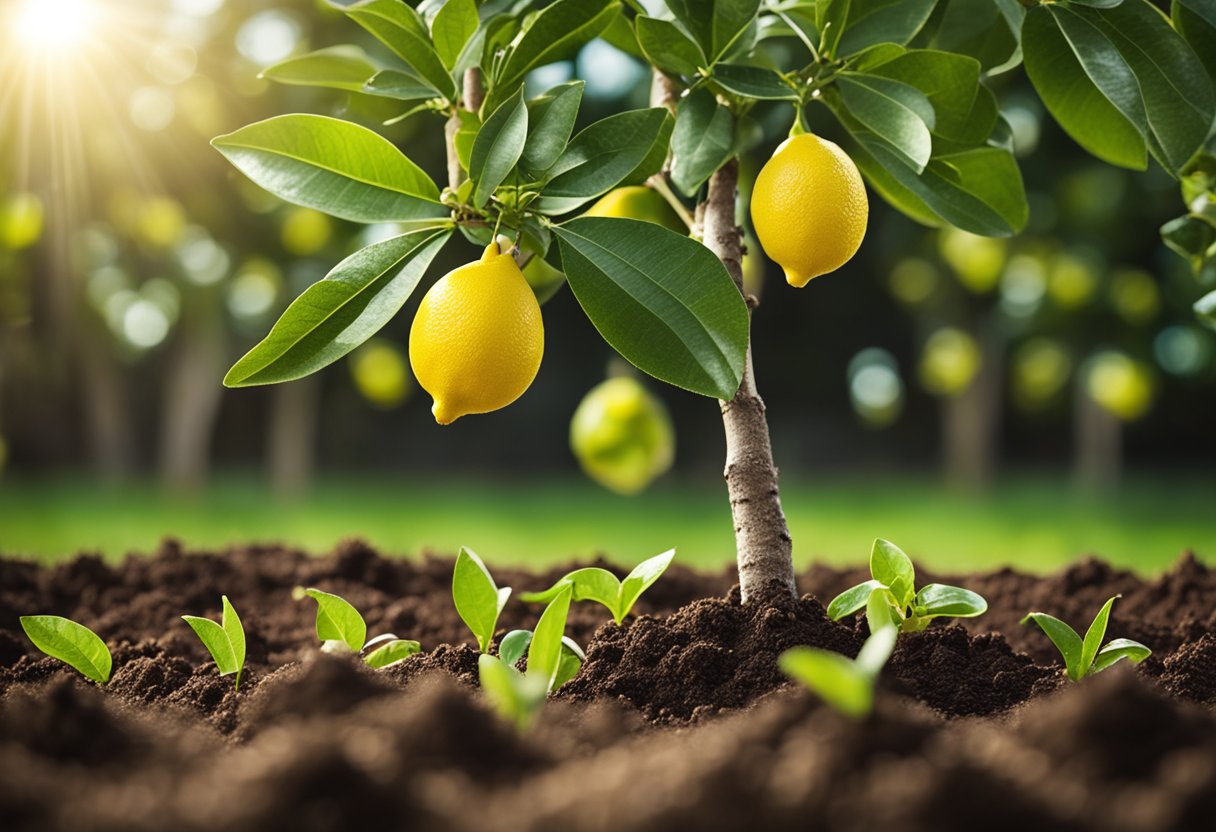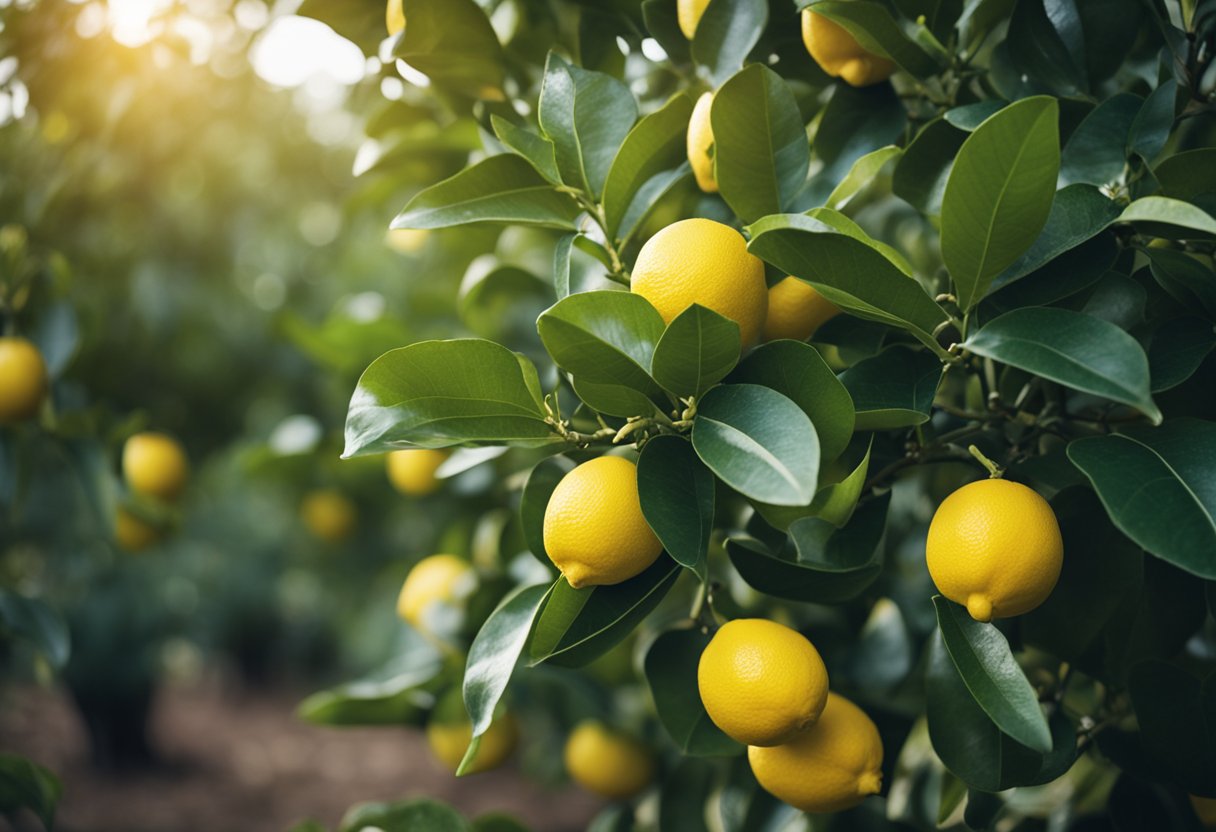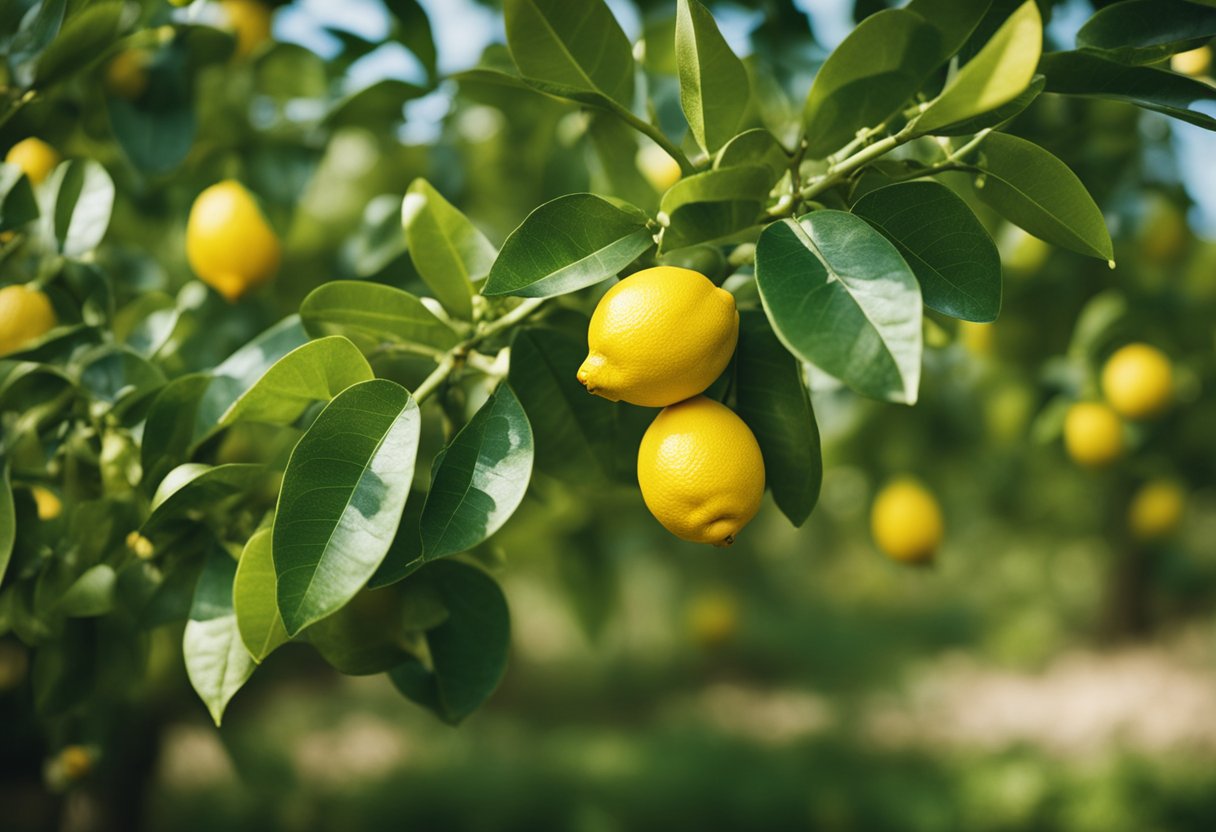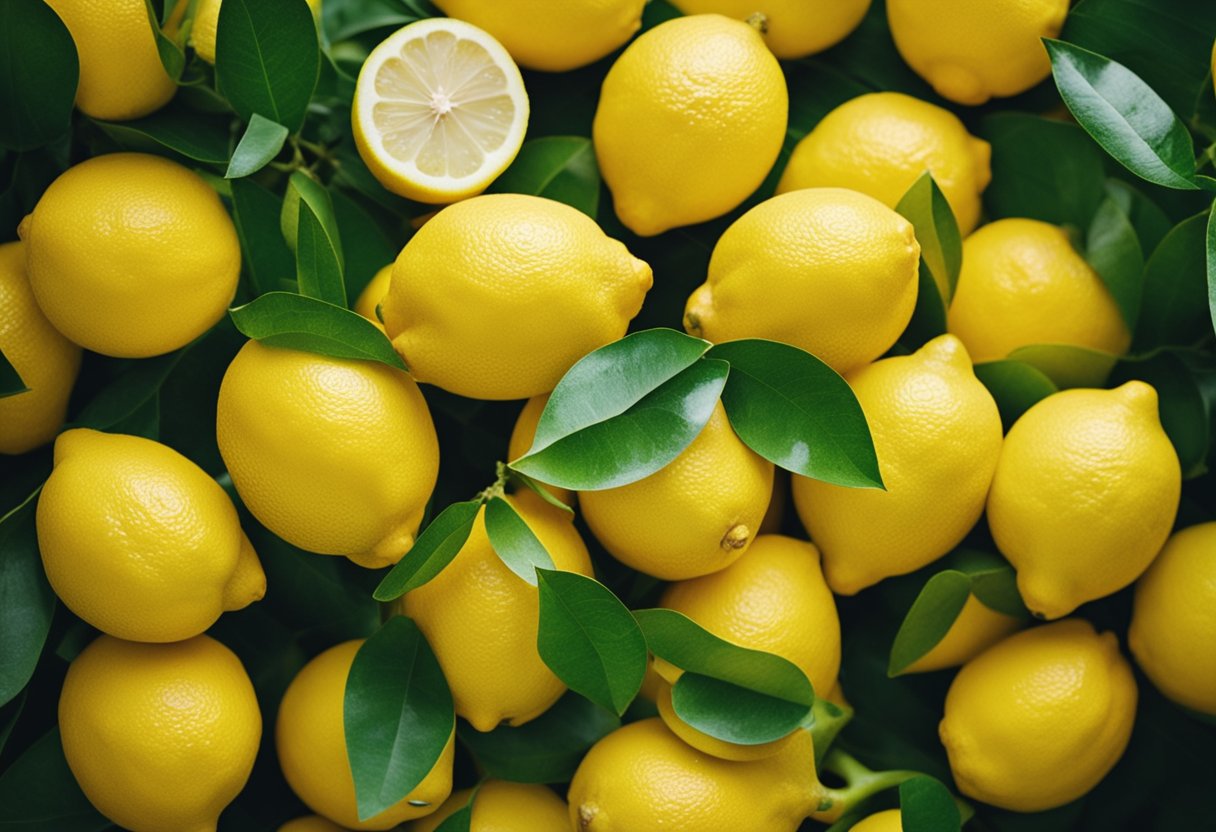Lemon trees are a popular choice for many gardeners, thanks to their fragrant blossoms and flavorful fruit. However, cultivating a lemon tree from seed or sapling requires patience, as it can take a substantial amount of time for the tree to produce fruit.
Understanding the growth timeline and various factors that affect lemon tree growth is essential for anyone looking to grow lemons either in their yard or indoors.

It generally takes a lemon tree about 4 to 6 years to start producing lemons, with the tree needing to develop fully before it produces fruit.
The specific timeline may vary based on the type of tree and variety of lemon, but overall, gardeners can expect to wait several years before enjoying their homegrown lemons source
To effectively grow a lemon tree, understanding optimal growing conditions and providing adequate care is vital. Lemon trees thrive in temperatures around 70°F (21°C) during the day and 55°F (13°C) at night, and require ample light to grow well (source).
By creating the right environment and nurturing the tree throughout its development, gardeners can maximize their chances of success in growing healthy lemon trees and eventually harvesting their fruit.
Understanding lemon growth
Lemon trees are a popular citrus tree variety known for their tart and tangy fruits. They thrive in warm climates and require specific care to grow and produce fruit.
There are several varieties of lemon trees, including the Meyer lemon, Eureka lemon, and Lisbon lemon. Each variety has its own growth rate, characteristics, and susceptibility to disease.
When considering how long it takes for lemons to grow, it is important to understand the growth stages of a lemon tree. Lemon trees begin their life cycle as seeds, which can germinate in 5-7 days under optimal conditions.
After germination, the young seedling develops roots and small leaves. As the tree grows, it will reach different heights at different ages. For example, at 2 years old, a lemon tree will be 2-3 feet tall, and at 6 years old, it may reach a height of 8-10 feet.
The time it takes for a lemon tree to produce fruit varies depending on the variety and conditions. On average, lemon trees can take 4-6 years to begin producing lemons, and they will reach their peak height at around 20-25 years old. The type of tree and variety of lemons determines the specific growth rate.

Care for a lemon tree greatly influences its growth and fruit production. Proper care includes well-draining soil, regular watering, and exposure to warm temperatures, especially in USDA hardiness zones 9 to 11.
Lemon tree care also involves selecting the right tree variety for the specific climate and environment it will be grown. Some lemon tree varieties, such as the Meyer lemon tree and the dwarf lemon tree, are better suited for smaller spaces or container gardening, while Eureka lemon trees and Lisbon lemon trees may require more space to grow.
It is crucial to monitor the health of a lemon tree regularly, as diseases and pests can weaken the tree and impact fruit production. Some common diseases that can affect lemon trees are citrus canker, greening, and root rot. Regularly inspecting the tree, applying appropriate treatments, and maintaining proper care practices will significantly improve the chances of growing a healthy, fruitful lemon tree.
In conclusion, the growth and fruit production of lemon trees depends on the variety, environmental conditions, and care provided. With proper attention and maintenance, lemon trees can be a beautiful and bountiful addition to a garden or landscape.
Related: How to Know if Persimmon is Ripe: Simple Expert Tips
Choosing the right lemon tree
When selecting a lemon tree for your garden or home, it’s essential to choose the right variety that best suits your needs and climate.
Purchasing a grafted lemon tree from a reputable nursery ensures that you’re getting a tree with the desired characteristics and helps reduce the time it takes for the tree to start producing fruit. Grafted lemon trees typically start fruiting within 5 years, while those grown from seeds can take 7-10 years to bear fruit 1.
Consider the available space in your planting area, as proper spacing is vital for optimal growth and productivity. In general, lemon trees require a spacing of about 12 to 25 feet apart, depending on the variety. Meyer lemon trees, for instance, are known for their versatile indoor or outdoor growth and require less space compared to other varieties 2.
When choosing a lemon tree, examine the root ball carefully for any signs of damage or disease. A healthy root ball should be firm and well-formed, without any visible roots circling the exterior. Avoid purchasing trees with damaged root systems, as this can negatively impact their growth and fruit production.
Two popular lemon varieties to consider include Eureka and Lisbon lemons, which are commonly found in grocery stores 3. These types of lemons have a thick skin and a classic lemon flavor.
Lisbon lemon trees, in particular, are known for their strong acid flavor, thin skin, and juiciness. They typically produce seedless fruit, making them an excellent choice for easy consumption and cooking.
In conclusion, choosing the right lemon tree involves selecting a suitable variety, purchasing a healthy grafted tree from a trustworthy nursery, ensuring the root ball is in good condition, and providing adequate spacing for growth. Considering these factors will help ensure that you have a thriving, productive lemon tree in your garden or home.
Indoor vs outdoor lemon trees
Indoor and outdoor lemon trees have different requirements when it comes to their growing environment. Both types can be successfully grown, but certain factors must be considered to ensure the tree’s health and fruit production.
When growing lemon trees indoors, they should be placed in an area with plenty of light, ideally near a south-facing window to receive as much sunlight as possible. Some gardeners even use grow lights to supplement natural light during winter months.

It’s important to rotate the container regularly for even light distribution and growth. As a houseplant, the lemon tree will be dependent on the gardener for proper watering, typically needing deep watering when the top 2 inches of soil have dried out (Bob Vila).
Outdoor lemon trees, on the other hand, thrive best in full sun for at least 6-8 hours a day. They require well-draining soil and adequate space to grow, as certain varieties can reach heights of 20-25 years before reaching their peak height.
Gardening in the backyard provides the tree with better access to crucial nutrients, often resulting in healthier trees and more abundant fruit production. Outdoor lemon trees require proper soil pH levels, ideally between 5.5 and 6.5, to optimize nutrient absorption (GardensNursery).
Climate is another essential factor for outdoor lemon trees. They prefer warm, temperate regions where the temperature does not dip below freezing, as frost can cause damage to the tree. Alternatively, indoor trees do not face such temperature fluctuations, making it easier to control the environment for optimal growth.
Both indoor and outdoor lemon trees require regular fertilization to maintain nutrient levels and ensure healthy growth. An 18-18-18 balanced fertilizer is recommended for both types of trees (Gardenista).
In summary, while both indoor and outdoor lemon trees can be successfully grown, there are different aspects to consider for each type. Optimal light, water, and nutrient requirements must be met for the tree to grow healthily and produce fruit, regardless of its location.
Lemon tree planting process
When planting a lemon tree, the first step is to choose a suitable pot with drainage holes to ensure proper water management. Selecting an appropriate pot is crucial, as it will affect the overall growth and health of the tree.

Next, select well-draining, fertile soil for planting the lemon tree. High-quality soil will provide the necessary nutrients for optimum growth and strong rooting. A mix of potting soil, perlite, and compost is typically recommended to ensure proper aeration and nutrient supply.
After preparing the pot and soil, the lemon tree must be planted correctly to ensure successful establishment. Begin by digging a hole in the soil that is twice as wide and deep as the root ball. If the tree has become root-bound, gently loosen its roots before placing it in the hole to encourage further growth and nutrient absorption.
Carefully lower the lemon tree into the hole and fill it with the prepared soil mix, gently pressing down to remove any air pockets. Make sure not to bury the tree too deeply, as the tree’s crown should remain above soil level. After the tree has been positioned, water it thoroughly to settle the soil around the roots.
Good water management is necessary for a lemon tree’s growth and productivity. Overwatering can lead to root rot, while underwatering can cause the tree to become stressed. Water the tree when the top few inches of the soil are dry, making sure that excess water drains out through the drainage holes and does not pool in the pot.
Lastly, repotting a lemon tree is essential as it grows, typically every two to three years. Transplanting the tree into a larger pot with fresh soil will ensure it has enough room to grow and receive proper nutrients. Be sure to water the tree well after repotting and provide adequate care for it to thrive.
By following these essential steps in the lemon tree planting process, you can create a suitable environment for the tree to flourish and produce juicy, delicious lemons.
Ideal growth conditions for lemons
Lemon trees thrive in a range of specific environmental conditions that can significantly impact their growth and fruit production. Understanding these factors can help cultivate healthy, fruitful trees.

Temperature: Lemon trees prefer warmer climates and require a consistent temperature range of 55-85°F (13-29°C). They can tolerate slightly lower temperatures, but frost and freezing conditions can lead to significant damage or even the loss of the tree. During colder months, monitoring and protecting the tree from extreme temperatures is crucial.
Soil Moisture: Lemon trees require moist, but well-drained soil. Overwatering can lead to root rot and other diseases, while underwatering can cause the tree to wilt and reduce fruit production.
It is essential to balance the soil moisture to maintain healthy growth. A good rule of thumb is to water when the top 2-3 inches of soil feels dry to the touch.
pH Levels: The ideal soil pH for lemon trees ranges from 6.0-7.5, although they can adapt to slightly more acidic or alkaline conditions. To ensure a healthy tree, regularly testing the soil pH and making necessary adjustments is advised.
Sunlight: Lemon trees thrive in environments with ample sunlight. They require full sunlight for at least 8-12 hours a day to reach their maximum potential. If the tree is planted in a location with partial shade or insufficient sunlight, it may produce fewer fruits and have slower growth.
Soil Type: A loose, well-draining soil, rich in nutrients, is key for lemon tree growth. Sandy loam or loamy soil types are ideal for both drainage and nutrient retention. Avoid heavy clay soils, as they can impede root development and water drainage.
By adhering to these ideal growth conditions, it is possible to cultivate thriving, fruitful lemon trees and optimize their fruit production.
Lemon tree care and maintenance
Caring for a lemon tree (Citrus limon) requires attention to its specific needs in order to grow healthy and fruitful. The first aspect to consider is watering. Lemon trees need regular watering to maintain consistent soil moisture. However, overwatering can lead to root rot, so it’s important to ensure proper drainage and not let the soil become waterlogged.

In colder climates, lemon trees may need to be moved indoors during winter months to protect them from freezing temperatures. When transitioning from winter to spring, it’s crucial to introduce the tree gradually to outdoor conditions. This can be done by placing the tree in a shaded area for a few hours each day, increasing the time spent outside progressively to avoid shock.
Fertilizing your lemon tree is essential for its overall health and productivity. Utilize a citrus-specific fertilizer or a general-purpose one, and follow the package instructions for the ideal frequency and amount. Additionally, make sure your lemon tree has access to essential nutrients, like iron, to prevent yellowing leaves and other health issues.
Pruning is another crucial aspect of lemon tree care. Regularly remove dead or damaged branches to promote new growth and air circulation.
Focus on maintaining the overall shape of the tree and removing branches that cross or rub against each other. Pruning should ideally be done in late winter or early spring when the tree is dormant.
Lemon trees are susceptible to various pests and diseases, such as citrus canker. Keep an eye out for signs of infection, like discolored or distorted leaves, and take immediate action to prevent the spread of disease. Use insecticides or natural remedies to control pests and ensure the tree’s health.
By following these guidelines, you can successfully care for and maintain a lemon tree, allowing it to grow and produce lemons for many years.
Common lemon tree diseases and pests
Lemon trees can be susceptible to various diseases and pests that can impact their growth and fruit production.

One issue that lemon trees may face is root rot, which is caused by fungal pathogens. This problem typically occurs when the tree’s roots are exposed to excessive moisture, making it important to ensure proper drainage and avoid overwatering.
Another common lemon tree disease is caused by a bacterium called huanglongbing, also known as citrus greening. This disease affects the entire tree and can lead to reduced fruit quality, as well as the eventual death of the tree. Early symptoms include yellowing leaves and poor fruit production.
Several pests can also cause problems for lemon trees, some of which include aphids, scale insects, and spider mites. Aphids are small insects that can cause damage by feeding on the tree’s sap, leading to leaf curling and yellowing. They can also transmit harmful viruses.
Scale insects pose a threat by causing sooty mold to grow on the tree’s leaves, which can reduce the tree’s ability to photosynthesize. Spider mites, on the other hand, can cause leaf damage and can be identified by the presence of fine webs.
To maintain optimal growing conditions and minimize the risk of diseases and pests, it is essential to plant lemon trees in well-draining soil and ensure they receive adequate sunlight.
Additionally, staying vigilant for signs of infection and addressing issues promptly can help promote the overall health of your lemon tree. It’s beneficial to keep in mind that lemon trees grow best in USDA zones 8-11, as they need a semi-tropical or tropical climate to thrive.
Overall, awareness of common lemon tree diseases and pests is crucial for maintaining a healthy tree and ensuring a successful harvest. By providing ideal growing conditions and monitoring the tree’s health, you can help prevent issues and enjoy the rewards of growing lemons.
Harvesting and using lemons
Lemons, a popular citrus fruit, are an essential ingredient in many dishes and beverages. To make the most out of your lemon tree, understanding the right time and method for harvesting is crucial.
Lemons are typically ready for harvest when they are yellow or yellow-green in appearance and firm to touch, with a size of about 2 to 3 inches [5-7.5 cm] ^(1^).

A common concern among lemon growers is fruit drop, which occurs when immature lemons fall from the tree. To avoid this issue, make sure your tree is not over-fertilized and receives adequate water ^(2^). Proper care will promote healthy growth and fruit production.
After harvesting the lemons, there are countless ways to make use of them. Fresh lemons can be used for seasoning dishes, adding a tangy twist to marinades, and providing a flavorful base for salad dressings.
Lemon juice is a staple in many beverages, from lemonade to cocktails. Moreover, lemon zest can enhance the flavor and aroma of various baked goods and desserts.

In addition to culinary uses, lemons provide a range of health benefits. This citrus fruit is rich in vitamin C, which supports the immune system and contains antioxidants that help fight against free radicals in the body.
By understanding the right time to harvest lemons and the multiple ways to use them, you can enjoy the full potential of your lemon tree.
Related: Peach Green Tea Lemonade
Propagating lemon trees
When it comes to propagating lemon trees, there are several methods that can be used, such as starting from seeds or using cuttings. Both options have their own advantages and requirements to successfully grow a lemon tree.
From Seeds: Starting lemon trees from seeds is an affordable way to grow them. To begin, collect the seeds from a ripe lemon and rinse them under cold water to remove any pulp.
Soak the viable seeds in a bowl of water for 24 hours to soften the hard seed coat, then wash the slimy coating off the seeds (see source). After the seeds are prepared, place them in a high-quality potting soil and keep the soil moist but not water-logged. Germination typically takes about 2 weeks, but can sometimes require more time.
From Cuttings: Another method for propagating lemon trees is through cuttings. Select a healthy branch from an established lemon tree and cut it at an angle.
Remove the lower leaves and dip the cut end into a rooting hormone. Afterward, place the cutting into a pot with well-draining, nutrient-rich soil. Keep the cutting moist and in a warm area with indirect sunlight until it develops a strong root system.
Regardless of the chosen method, proper pollination of lemon trees is essential for fruit production. Lemon trees are self-pollinating, meaning they can produce fruit on their own without cross-pollination from other trees.
Nonetheless, pollinators like bees and butterflies can help improve fruit production. To ensure success, lemon tree seedlings or cuttings should be transferred to a larger pot or planted outdoors once they have developed a robust root system.
Caring for young lemon trees involves providing them with enough water and nutrients to grow strong and healthy. Regularly watering them, especially during the first few weeks, is crucial to promote root establishment, and adding mulch can help retain moisture in the soil as well as regulate soil temperature (source.
In conclusion, propagating lemon trees can be accomplished through seeds or cuttings. Both methods require attention to detail and proper care. With patience and dedication, young lemon trees can grow well and eventually produce delicious and juicy fruits.
Special lemon tree varieties
Among the numerous types of lemon trees, some stand out for their unique characteristics and adaptability to various growing conditions.
One such variety is the Meyer lemon, which is favored by many for its sweeter, less acidic fruit. This variety is also known to be a dwarf lemon tree, making it suitable for small gardens and even as a houseplant.
Thorns are a common feature on many citrus trees, but Meyer lemons are known for having fewer thorns compared to other varieties. This makes them a popular choice for home growers, as they are less likely to cause injury during pruning or fruit harvesting.
Another interesting lemon tree variety is the Ponderosa lemon. This tree produces exceptionally large fruits, sometimes weighing up to two pounds.

The Ponderosa lemon tree can also be grown as a houseplant, given sufficient sunlight and humidity. Using a humidifier in the room can help maintain the necessary growing conditions for this tree.
Lemon seeds from these special varieties can be used to grow new trees, but it’s important to note that the resulting trees might not always produce the exact same fruit characteristics due to genetic variation. To ensure consistent fruit quality, many growers prefer to propagate their lemon trees through methods such as grafting or air layering.
Both Meyer lemon and Ponderosa lemon trees, like other citrus varieties, require a good supply of nutrients for healthy growth. A fertilizer high in nitrogen will help promote lush foliage and optimal fruit production. Additionally, these trees benefit from well-draining soil, as they are susceptible to root rot when exposed to excessive moisture.
One of the key advantages of these special lemon tree varieties is their ability to self-pollinate. This characteristic makes them ideal choices for growing indoors, as they do not require a pollinator to produce fruit. As houseplants, they can flourish in a sunny spot by a window, providing both attractive foliage and delicious fruit for the home gardener.
Historical and cultural significance of lemons
Lemons have held a significant position in various cultures, particularly in Asia, where they are believed to have originated. The exact origins of the lemon are unknown, but some sources point to Northeast India, such as the region of Assam, as a possible location for their beginnings (see source).
The first known mention of lemons can be traced back to the 14th-century Treatise on Agriculture by Ibn Luyun, a writer and poet from Almeria, Spain (the source).
Due to their versatile culinary and medicinal properties, lemons have been sought after and celebrated in various parts of the world for centuries. As lemon trees spread across the globe, the citrus fruit adapted to different climates and took on diverse cultural roles. In Europe, Lisbon became known for its production of high-quality lemons, which contributed to the city’s thriving trade (source).
The iconic lemon flavor found its way into numerous dishes, desserts, and beverages, demonstrating the fruit’s importance in gastronomy. Beyond culinary uses, lemons were also cultivated for their various medicinal properties. Ibn Jumay, a physician in the court of Saladin, published the first recipe for preserving citrus fruit in Cairo, along with medicinal recipes that prominently featured lemons.
The distinct nature of the lemon, with its vibrant color, tangy taste, and unmistakable scent, has elevated this citrus fruit to a beloved symbol in art. Depicted in numerous still-life paintings, lemons have become a timeless motif, representing the beauty and mystery of nature itself.
In conclusion, the historical and cultural significance of lemons is evident in their impact on cuisine, medicine, art, and trade. Whether they are grown in Asia, Lisbon, or elsewhere in the world, lemons’ enduring appeal speaks to their versatility and the important role they have played across diverse cultures and historical events.
